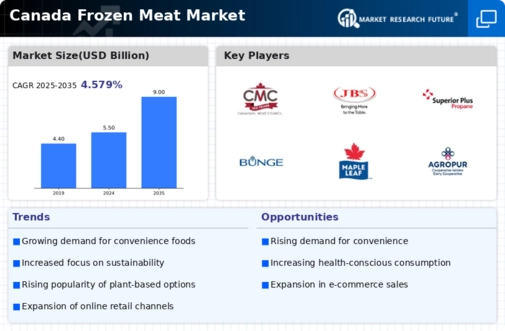Increasing Health Consciousness
The frozen meat market in Canada is experiencing a notable shift as consumers become increasingly health-conscious. This trend is reflected in the growing preference for leaner cuts and organic options, which are perceived as healthier alternatives. According to recent data, the demand for organic frozen meat products has surged by approximately 15% over the past year. This shift is likely driven by a heightened awareness of nutrition and the desire for high-quality protein sources. As a result, the frozen meat market is adapting to these preferences by expanding its offerings to include a wider range of health-oriented products. Retailers are also emphasizing the nutritional benefits of frozen meat, which retains its quality and flavor while providing essential nutrients. This focus on health is expected to continue influencing purchasing decisions, thereby shaping the future landscape of the frozen meat market.
Sustainability and Ethical Sourcing
Sustainability has emerged as a critical driver in the frozen meat market, particularly in Canada, where consumers are becoming more environmentally conscious. There is a growing demand for products that are sourced ethically and produced with minimal environmental impact. Recent surveys indicate that nearly 70% of Canadian consumers are willing to pay a premium for sustainably sourced frozen meat. This trend is prompting producers to adopt more responsible practices, such as reducing carbon footprints and ensuring humane treatment of animals. The frozen meat market is responding by highlighting these sustainable practices in marketing efforts, thereby appealing to a demographic that prioritizes ethical consumption. As awareness of environmental issues continues to rise, the industry is likely to evolve further, aligning with consumer values and preferences.
Convenience and Time-Saving Solutions
In the fast-paced lifestyle of modern Canadians, convenience plays a pivotal role in food purchasing decisions. The frozen meat market is capitalizing on this trend by offering products that cater to the need for quick and easy meal solutions. Frozen meat products require minimal preparation time, making them an attractive option for busy households. Recent statistics indicate that approximately 60% of Canadian consumers prefer frozen meat for its convenience, particularly for weeknight dinners. This preference is further supported by the increasing availability of pre-marinated and ready-to-cook frozen meat options. As consumers seek to balance their time between work and family, the frozen meat market is likely to see sustained growth driven by the demand for convenient meal solutions that do not compromise on quality.
Technological Advancements in Supply Chain
The frozen meat market in Canada is benefiting from technological advancements that enhance supply chain efficiency. Innovations in logistics, such as improved cold chain management and tracking systems, are enabling producers to maintain product quality from farm to table. Recent data suggests that the implementation of advanced technologies has reduced spoilage rates by up to 20%, thereby increasing overall market efficiency. Additionally, these advancements facilitate better inventory management, allowing retailers to respond swiftly to consumer demand. As the industry embraces these technologies, it is likely to see a positive impact on profitability and customer satisfaction. The integration of technology into the supply chain is expected to be a key driver for growth in the frozen meat market, ensuring that products remain fresh and accessible to consumers.
Rising Popularity of International Cuisines
The frozen meat market in Canada is witnessing a surge in demand driven by the increasing popularity of international cuisines. As Canadians become more adventurous in their culinary choices, there is a growing interest in diverse meat products that cater to various cultural tastes. This trend is reflected in the rising sales of frozen meat items such as marinated cuts and specialty products from different regions. Recent market analysis indicates that frozen meat products inspired by Asian and Mediterranean cuisines have seen a growth rate of approximately 25% over the last year. This diversification not only enriches the consumer experience but also encourages the frozen meat market to innovate and expand its product lines. As the appetite for global flavors continues to grow, the industry is likely to adapt, offering a wider array of frozen meat options that resonate with Canadian consumers.

















Leave a Comment